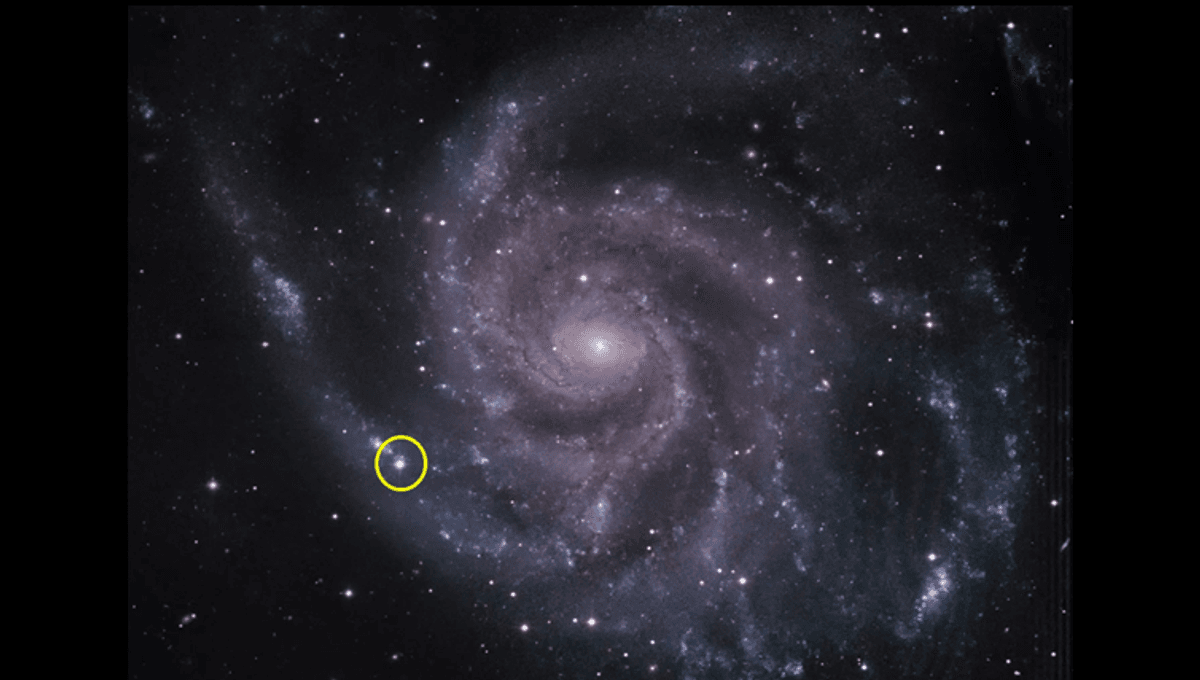
The supernova SN 2023ixf offered astronomers an unusual opportunity when it exploded last year. Unfortunately, it has deepened, rather than resolved, the problem of explaining cosmic rays. It’s also thrown models of supernovae into doubt, but hey, if we had all the answers, we wouldn’t need scientists.
We now detect thousands of supernovae each year, but most of these are billions of light years away, limiting how much we can learn about them on an individual basis. At 21 million light years away, SN 2023ixf was just around the celestial block, by comparison.
This gave amateurs the opportunity to collect some stunning images of the supernova and its host galaxy, the Pinwheel. For professional astronomers, it represented the best chance to study a supernova’s gamma ray production since 2008, when the Fermi space telescope was launched.
“Astrophysicists previously estimated that supernovae convert about 10% of their total energy into cosmic ray acceleration,” said Dr Guillem Martí-Devesa of the University of Trieste in a statement. “But we have never observed this process directly.”
Cosmic rays are charged particles (mostly protons) that have been accelerated close to light speed by some sort of astronomical event. They bombard the Earth constantly, and can have important effects on the atmosphere, such as producing the carbon-14 we use to measure the age of artifacts. However, when astronomers say they are produced by astronomical events, they are making assumptions based on there being no obvious alternative explanation. We don’t know what events produce them and in what quantities.
It might seem like this should be easy to test – wait until we spot something dramatic happening and look for the rays afterward. However, there are two problems with this. Firstly, the delay can be rather long. Even if something is traveling at 99.9 percent of the speed of light, it can lag the photons released at the same time by thousands of years if the distance is great enough. Secondly, magnetic fields, including the Earth’s, bend the paths of incoming charged particles, so we can’t identify the direction they are coming from precisely.
Fortunately, cosmic rays produce gamma rays when they pass through something other than a complete vacuum. Once formed, the gamma rays don’t deviate for magnetic fields (or much else, other than very large masses’ gravity). A burst of cosmic rays encountering gas clouds around the supernova should have produced gamma rays whose source could be traced. SN 2023ixf therefore provided an excellent opportunity to see how many associated gamma rays we could find.
The answer turned out to be none, at least nothing significantly above background. “Fermi is the most sensitive gamma-ray telescope in orbit, so when it doesn’t detect an expected signal, scientists must explain the absence. Solving that mystery will build a more accurate picture of cosmic ray origins,” said Dr Elizabeth Hays of NASA’s Goffard Space Flight Center.
“With the new observations of SN 2023ixf, our calculations result in an energy conversion as low as 1% within a few days after the explosion. This doesn’t rule out supernovae as cosmic ray factories, but it does mean we have more to learn about their production,” Martí-Devesa added.
There are different types of supernovae, so just because one doesn’t seem to have produced a lot of cosmic rays, doesn’t mean none do. To test that, we’re going to need more nearby supernovae, so it is just as well one was spotted at almost the same distance last week. The authors are also considering the possibility that 2023ixf did produce a lot of cosmic rays, but they, and the resulting gamma rays, were directed away from us. More study subjects could be handy in that case as well.
Nevertheless, the findings are a puzzle. Supernovae (Type Ia aside) involve giant stars collapsing and then rebounding, producing a shock wave that ought to drive particles before it to create cosmic rays. If 2023ixf didn’t create many, that takes some explaining.
Moreover, it’s more than a decade since Fermi observations proved supernovae remnants thousands of years old are still slinging cosmic rays at us, which then generate gamma rays as they pass through nearby material thrown off before the explosion.
However, the rate of production of these remnants can’t account for all the cosmic rays we see – either most are released in the explosion itself, or there’s some other source out there. The 10 percent of supernovae energy going into cosmic rays would neatly explain the number and spectrum we see after allowing for those produced by remnants. If the figure is 1 percent, that leaves most unaccounted for. That’s why Fermi’s failure to detect any from 2023ixf raises more questions than it answers.
The study is to be published in Astronomy and Astrophysics.
Source Link: Nearby Supernova Was Surprisingly Lacking In Cosmic Rays, Throwing Doubts On Theories